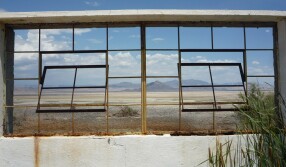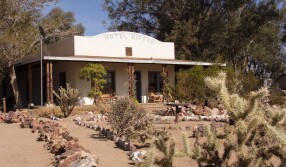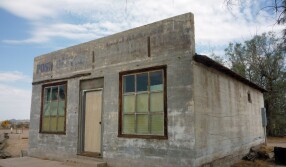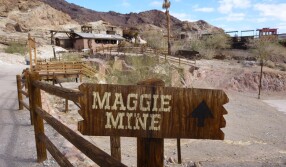Where to Find the Mojave's Greatest Ghost Towns

California has an embarrassment of riches when it comes to ghost towns, thanks to not only the Gold Rush but also to mining for other metals and materials, rockhounding, and prospecting for gemstones.
Those towns that didn’t have a mine provided a necessary stopover point for overland wagons and freight and passenger trains that traveled between the places that did. But as those mines stopped producing – or never produced at all – miners moved onto other mountain ranges and those waystations were no longer needed.
New towns subsequently popped up as cross-country automobiling came into fashion – thanks to the creation of the National Trails Highway and, eventually, Route 66 (which once ran continuously from Santa Monica, CA to Chicago, IL) – but they, too, became circumvented as faster freeways like the I-15 and the I-40 were better built for the “long haul” and ended up bypassing the businesses along the way.
Some of our Southern California ghost towns are buried so deeply in our national parks that you can only hike to them. Others are just a mere blip on the GPS, noted with a historical marker and maybe a shoetree or some other folk monument of its former life.
But here are six ghost towns in the Mojave Desert that you can easily visit by car, really see something and maybe even meet some people (though not many).
1. Zzyzx, CA


If you’ve ever found yourself driving along the I-15 at the northern border of the Mojave National Preserve, you’ve probably seen the exit sign for Zzyzx and wondered what could possibly there. Trust me – next time, get off the freeway, and go explore this mesmerizing place. On your way down Zzyzx Road (which has recently been paved), keep an eye out for bighorn sheep as you approach the magical mineral springs of the former Soda Springs / Zzyzx Healing Center, past the salt flat of Soda Lake. Now, Zzyzx Road and Soda Lake are part of the Mojave Preserve, and the former healing center has been taken over by the Desert Studies Center, a field studies division of California State University Fullerton. But this place once housed a sham facility to heal elderly travelers passing through along the old Mojave Road (as well as those stopping over along the old T&T Railroad). Zzyzx was founded by a self-proclaimed "last of the old-time medicine men": Curtis Howe Springer a popular radio evangelist from the East who, like many, had come to conquer the west and capitalize on the mineral-rich land. He'd already built some successful resort-type spas in Pennsylvania, and then filed a mining claim on the land. But instead of mining the land, he and his wife built an encampment of tents and concrete buildings around a palm tree-lined oasis (known as Lake Tuendae, which lays claim to fish like the endangered Mohave tui chub). Although the minerals were — and are — real at Zzyzx, the hot springs were not. (They were faked with the help of a boiler.) He had a good 30-year run before being evicted in 1976 for quackery (among other claims). This little community looks practically untouched since then, despite the students who still study there today.
Note that Zzyzx has been transformed into an active educational campus. Please don't enter any structures without permission.
2. Amboy, CA


Amboy is probably the most famous of the Route 66 ghost towns in the Mojave Desert, thanks to its appearances in various movies and fashion magazines. Now, it’s more or less just a set – a filming location for hire – with a population of 20, if you believe the sign. (It’s probably less.) Originally settled along the ever-expanding rail route, Amboy experienced a boom with the opening of Route 66 and once had enough local residents to warrant a school. But, as many of those towns did with the opening of the new 40 Freeway in the 1970s, Amboy fell out of favor. The town itself has been bought and sold, and the iconic Roy’s Café has alternated between open and closed. But the one consistent thing in Amboy is its crater – a volcanic cinder cone that’s also a national natural landmark, managed by the BLM. You can climb up a relatively easy trail to the rim, but do it early in the day and not in the dead of summer. There’s no shade to be had at Amboy Crater – and no one nearby to hear your screams if you find yourself in distress.
3. Nipton, CA

Located near the California / Nevada state line, this so-called “Gateway to the Mojave Desert” is a little off the beaten path to be a good rest stop on your way to or from Vegas, but it’s worth the detour. In the 19th century, Nipton was at the nexus of both silver and gold mining in the Ivanpah Valley and of two intersecting overland wagon trails (one running north-south and the other running east-west). Officially founded in 1905, it became a 20th century railroad depot town. But now, it’s got less than 100 permanent residents, though it attracts packs of bikers and other desert visitors, who can stay at the Hotel Nipton (and hope for a chance encounter with the ghost of Clara Bow, the silent film star who apparently once owned a ranch nearby). The townsfolk – and its owner since the 1980s – have done their best to operate with renewable energy and get off the grid as much as possible, even installing a local power plant. That means the Trading Post accepts cash only (no credit cards) and you won’t find an ATM or a gas station in town, although you can stop at the Shell on Cima Road (west of Nipton, on the way south to another ghost town, Cima) for some modern amenities and an animatronic roadside mannequin display that’s not to be missed. If you’ve got big dreams for a small town, you can buy the entire town of Nipton — all 80,000 acres — for a mere $3 million. It’s for sale again.
4. Kelso, CA


In 1905, Kelso was built specifically as a depot along the railroad line that ran between L.A. and Utah and cut right through the middle of the Mojave Desert (in the area that’s now known as the Mojave National Preserve). But business was so big that Kelso ended up becoming a real town, with a post office (now closed, but still standing) and, in the 1940s, a jail for drunkards (also vacant, but there). The original, simple train depot was replaced with a much larger one in 1925 that also functioned as a boarding house for railroad employees and a restaurant. The depot officially closed in 1962 after mining dwindled and freight trains switched from steam to diesel, although the housing and dining facilities for crewmembers remained open until 1985. Now, Kelso Depot has been preserved as a visitor’s center where you can explore historical exhibits in the former dormitory rooms, baggage room, and ticket office. Grab some spare water and a hiking guide or a map in the bookstore before heading out to Kelso Dunes or any number of the cinder cones and lava flows accessible off of Kelbaker Road (the thoroughfare that connects Kelso to Baker, CA). Tell a ranger at the visitor’s center where you’re headed, and be sure to ask if your car (especially if it’s a low-clearance passenger car with 2WD) can make it. And even if the ranger says it can, be extra careful when you’re parking on uneven terrain with possibly deep sand.
5. Calico, CA

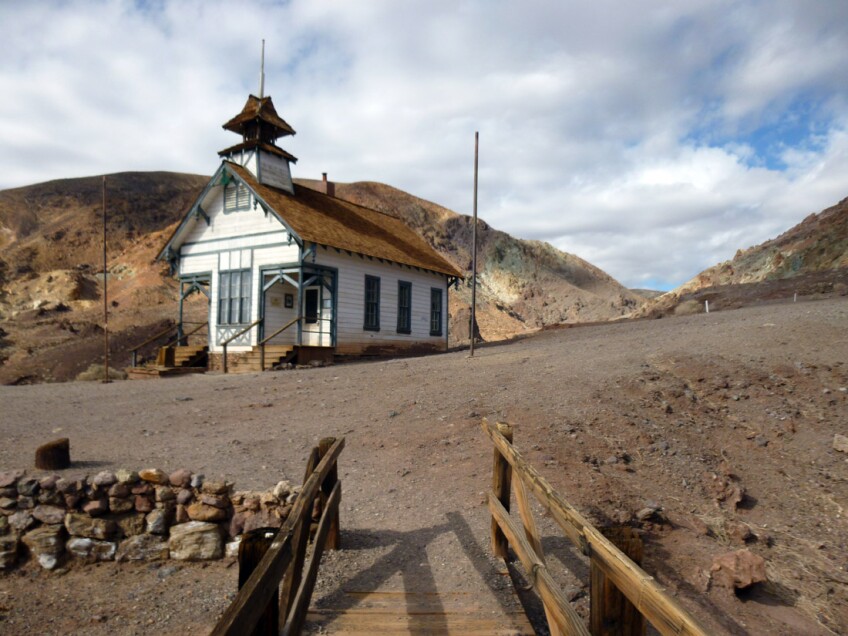
Nestled in the Calico Mountains, Calico is both a ghost town and an amusement park – but don’t let its overt commercialism keep you from visiting, because there’s plenty of history there, too. It was originally part of the largest silver strike in California, but now only five original buildings remain -- the rest having perished in fire. There's the park office and the Lane House & Museum, restored in 1979 and named after Lucy Bell Lane, Calico's most distinguished and long-term resident. There’s also the Lane grocery store, the saloon, and the Zenda Mining Company -- all original structures are distinguishable by their "rammed earth" architectural style, which is much more fireproof than wooden structures. The Zenda Mining Company was the last owner of Calico as a mining town, until they sold it to Walter Knott of Knott's Berry Farm fame. Some historical ruins like those of the Chinese mining camps have been preserved, but Knott rebuilt other iconic structures, supposedly to their original specifications. Ironically, one of them is a garage that houses a historic fire truck. The theme park attractions are in full force here, too – like the bottle house, Mystery Shack, and Maggie Mine. Once a working mine in the 1880s, Maggie Mine is now the only mine at Calico that's safe for guests to enter. After your walk-through mine tour, climb atop the rock formations above the mine and look down upon the surreal town below, as you listen to the epic booms of training exercises occurring at Fort Irwin next door.
6. Daggett, CA


Located east of Barstow, Daggett has fared only slightly better than its fellow Mojave Desert ghost towns, despite being located right off of the 40 Freeway and not having had any traffic circumvented away from it. With a population now of around 200 locals (though more in surrounding areas like Yermo), it’s been the site of two large-scale but failed solar projects. It was also the site of a stamp mill for the silver mining rush that was happening across the way in the Calico Mountains, as well as borax production (after Harmony Borax Works in Death Valley closed, but before the town of Boron’s supply was discovered). Drive around these days, and you might recognize some of the buildings as seen in the movie version of "The Grapes of Wrath." Stop by the Daggett Pioneer Cemetery to peruse the gravestones of early settlers dating back to the late 19th and early 20th centuries. Stock up on some supplies at the funky Desert Market, or stay a little longer at the Desert Springs RV Park on Daggett-Yermo Road, just north of the center of town.
